Thesis: Amid legislative changes, prolonged economic uncertainty and recent shifts in the banking landscape, banks and fintechs are in a unique position to combine their strengths and offerings to reach business owners in communities that typically face additional barriers to securing funding.
Underserved Communities – the missing piece?
Current macroeconomic factors, especially a tightening credit market, have made operating a small business increasingly difficult for business owners across the U.S. Further complications including complex small business loan application processes and time-consuming origination timelines, continue to hamper the smallest of small businesses, shutting them out from the funding they desperately need.
According to the U.S. Chamber of Commerce, two-thirds of small businesses (66%) say that rising interest rates are limiting their ability to raise capital or financing for their business, and another 46% say that not having enough revenue or assets to qualify for a loan makes it difficult for them to get financing. Additionally, newly released data from the Federal Reserve reveals that excluding the start of the pandemic, it hasn’t been this hard to obtain a loan since the 2008 crisis.
To alleviate this pain point for small business owners, fintech lending institutions seek to make obtaining financing as frictionless and efficient as possible. Solutions that offer increased transparency in fee and interest rates, detailed servicing timelines and capabilities, and differentiated product offerings are key to reaching small business owners who struggle to secure funding from traditional lending institutions.
Addressing struggles related to accessing capital is especially important for minority-owned small businesses. According to a recent survey from Intuit QuickBooks, 57% of Black business owners say they were denied a bank loan at least once when starting their business – compared to only 37% of non-Black business owners. In addition, 46% of Hispanic-Latino business owners have faced issues accessing capital, according to a recent report from Bank of America.
Further, minority-owned businesses are disproportionally impacted by today’s credit tightening – 51% of Black-owned businesses, 40% of Hispanic-owned businesses, 36% of Asian-owned businesses, and 30% of White-owned businesses site financial challenges due to lack of credit availability, as reported in a recent Small Business Credit Survey Report on Minority Owned Firms.
Common Barriers to Accessing Funding
Whether they can’t qualify for business loans due to legacy credit scoring systems or have niche servicing needs that traditional lenders can’t provide for, some small business owners have effectively been shut out of the business loan landscape.
Small business owners cite various barriers to securing financing for their business. According to data from the U.S. Chamber of Commerce, more than half (52%) of small business owners cite having faced a time-consuming application process in order to receive funding, and 46% say they don’t have enough information on available sources of capital. About half (46%) also say that they do not have enough revenue to qualify for a loan.
In addition, the issue of having difficulty securing funding is significantly more likely to affect the smallest of small businesses. More than half (55%) or small businesses with 5-19 employees and 41% of businesses with fewer than five employees say they have good access to capital, compared to 73% of businesses with 20-500 employees.
Strength in Bank-Fintech Partnerships
Fintech companies are continuously looking for and implementing ways to solve some of those challenges. Small business lenders offer technology solutions that can revolutionize the small business lending processes typically used by traditional lending institutions. For example, cutting-edge technology such as machine learning can quickly assess credit scoring data to more accurately risk-rank business credit scores and provide additional support for small business owners.
In fact, fintech lending institutions have already leveraged machine learning to increase access to capital for traditionally underserved communities. According to a study from The Philadelphia Federal Reserve and the Bank for International Settlements, Funding Circle and LendingClub were able to expand access to capital to small businesses through their industry leading machine learning technology. Specialized internal credit scores that utilize machine learning data allow Funding Circle to lend to many business owners who don’t have access to bank loans due to their FICO score, improving small business owners’ access to capital and offering greater financial inclusion.
According to the study, Funding Circle assigns risk ratings to loans that are able to predict future loan performance more accurately than the conventional method of credit scoring, leading to better loan performance. The information used by Funding Circle to risk rank loans is superior to that of risk measures from FICO or VantageScore as defined by the number of loans that end in default on behalf of the borrower (“about a one-third variation in loan default probability,” per the study).
Additionally, Funding Circle’s unique underwriting technology enables rapid decision-making so that banks can fund more borrowers, in significantly less time, while still maintaining credit quality. These underwriting services, combined with efficient loan servicing and fast loan origination times are especially important to small business owners and can be provided by fintech lenders.
Banks possess the capital needed to invest in new lending technology, as well as relationships with customers that desire access to innovative lending products and services. By combining the strong community reputation of both large and regional banks with the technology offered by fintech lenders, both parties can work together to offer lending products more quickly and conveniently, while helping to increase access to capital for small businesses across the U.S.


